| May-27-09 | | shalgo: This is a wonderful game by Schlechter. By preventing Black from advancing his d-pawn, White ends up playing the game essentially up a rook and knight. The sacrifice 31.e6! leads to a picturesque position after 31...dxe6 32.Qe5: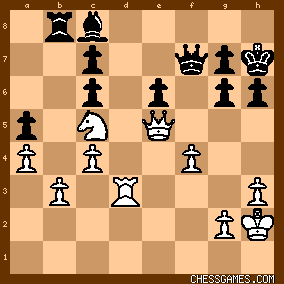
click for larger viewBlack is completely helpless in the face of White's coming attack. |
|
| Jul-31-09 | | totololo: All the classical precepts: Advantage --> attack the King --> position advance with the fireworks at the end! |
|
| Nov-07-09 | | badenbaden: Una magnífica partida de Schlechter, muy característica de su estilo.
¡Maravillosa partida de Karl Schlechter!
<Al jugador de ajedrez le encantará hundirse en las profundas partidas de Schlechter, donde, junto a la inmensidad y la sencillez natural, hallará la graciosa ligereza del arte y de la música vieneses, las deslumbrantes combinaciones de los maestros clásicos y, asimismo, el juego posicional de los jóvenes maestros desarrollado en sus mínimos y más sutiles detalles.>
(Reti: «Nuevas Ideas en Ajedrez») |
|
Oct-16-17
 | | KEG: An excellent game by Schlechter. Janowski repeats a variation in the Berlin Defense to the Ruy Lopez with which he had defeated Tchigorin in London the year before, but Schlechter improves on Tchigorin's play, exploits an error by Janowski on move 17 and never lets Janowski back in the game. The manner in which Schlechter constricts Janowski's position and blocks his every effort at counterplay is in the style of Karpov at his very best. 1. e4 e5
2. Nf3 Nc6
3. Bb5 Nf6
4. 0-0 Nxe4
5. d4 Be7
6. Qe2
6. Qd3 or 6. Re1 appear more logical, but Kasparov prefers the text and in fact gives it a "!". 6... Nd6
7, BxN bxB
8. dxe5 Nb2
This move was popular at the time (and afterwards as well) but it looks bad to me. Why lock up the Black position like this. 8...Bf5 seems much better. 9. Re1
Either Kasparov's 9. Nc3 or 9. Nd4 seem much better, but once again the text was popular then and continues to be played. NOTE: The Tournament Book gives this move as 9. Rd1, but that seems clearly to be an error. 9. 0-0
10. Nc3 Re8
Recommended by Lasker.
According to Teichmann, the line played by Schlechter here "proves" the text to be bad. Schlechter agrees with this assessment. But this is surely an overstatement, and as will be seen, Black retains counterchances even after the text. Teichmann's suggestion, 10...d5, seems quite bad after 11. exd6 e.p. Bxd6. Black's pawn structure is shattered and he has no compensation for his weaknesses. Best seems Kasparov's 10...Nc5.
11. Qc4
This move was first proposed by Alapin, and it is undoubtedly an improvement over the earlier 11. Bf4. It is also am improvement on 11. Be3 as played by Marco against Janowski. 11... Nc5
12. Ng5
Teichmann and others praise this continuation of Alapin's idea, but Pillsbury's 12. Be3 may be the best move of all. 12... BxN
Perhaps simplest is 12...Ne6, but the text is certainly playable. The claims in some of the contemporary commentaries that White has something close to a won game here seem unfounded. 13. BxB QxB
14. QxN Re6
The position was now as follows:
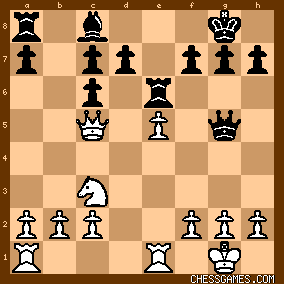
click for larger view15. Qd4
This is Schlechter's new move. Tchigorin got nothing against Janowski with 15. Rad1 and eventually lost. Schlechter and Marco argue that the text is better than 15. g3 which was also played in this line, but I disagree. 5. g3 is quite logical, and cuts off any mating ideas on g2. Perhaps the best move here for White is 15. Qh5. One thing is for sure, Janowski was not prepared for the text, and quickly got in trouble. 15... Bb7
The Tournament Book gives this a "?". Janowski's sacrifice of his d-pawn to create mating threats on g2 with the Bishop is a pipe-dream that Schlechter quickly snuffs out. Best was 15...Qe7 addressing all of White's immediate threats. 16. Qb4!
While Schlechter could have grabbed a pawn with 16. Qxd7, there was no need to do so. Instead, he ties Janowski up in knots. Indeed, after the text Janowski's Bishop remains marooned on c8 for the rest of the game. 16... Bc8
16...Ba6 would be crushed by 17. Qa5 as Schlechter pointed out (much stronger that Rosenthal's 17. Ne4). 16...Rb8 also loses (to 17. Ne4--as was also pointed out by Schlechter). Thus,Janowski's 16...Bc8 is forced. 17. Ne4
Just about the only move by Schlechter in this game with which I take serious issue. Stronger was 17. f4 immediately. A key question now arises. Can Janowski accept Schlechter's offer and grab the pawn on e5? I will discuss this issue as well as the follow-up in my next post on this game. |
|
| Oct-16-17 | | Straclonoor: Many thanks, KEG, for commenting this superb game! it's my favorite game (c)-:))) by Schlechter.
Some questions
<7, BxN bxB
8. dxe5 Nb2 > probably 8....Nb7 ?
<Why lock up the Black position like this. 8...Bf5 seems much better.> Sorry, black can't move 8....Bf5 in this variation because black pawn till on d7.<This move was popular at the time (and afterwards as well) but it looks bad to me.> Require long discussion. |
|
Oct-16-17
 | | keypusher: <KEG> Thanks for your analysis! Incidentally, Lasker played 10....Nc5 three times in the Tarrasch match. The games continued with a modified version of of Teichmann's 10....d5 suggestion: 11.Nd4 Ne6 12.Be3 Nxd4 13.Bxd4 c5 14.Be3 d5 15.exd6 Bxd6. d7-d5 is probably better on move 14 than on move 10, but it's hard to believe Black has full compensation for the pawn weaknesses (SF is skeptical). Tarrasch vs Lasker, 1908 Tarrasch vs Lasker, 1908 Tarrasch vs Lasker, 1908 Teichmann apparently learned of 14....d5 during a tour of Latin America, hence the name Rio de Janeiro variation. |
|
Oct-16-17
 | | KEG: <Straclonoor> Sorry for the typo. I intended to suggest 8...Nf5. As you note, 8...Bf5 would be impossible. |
|
Oct-16-17
 | | KEG: <keypusher> Thank you for your comments. I had forgotten about Lasker's 10...Nc5 in the Tarrasch match and I didn't know the pedigree of the name (Rio de Janeiro variation). Fascinating game. I will supplement my analysis with comments on the rest of the game when time permits. |
|
Oct-17-17
 | | KEG: After Schlechter's 17. Ne4, the position was as follows: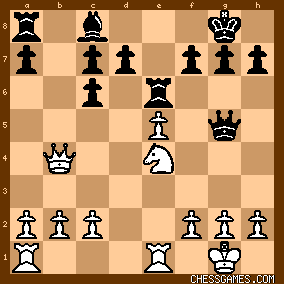
click for larger viewAt this key moment in the game, Janowski played: 17... Qe2
The question, needless to say, is whether Janowski could and should have grabbed a pawn with 17...Qxe5. The contemporary commentators engaged in a lively debate on this point. They all agree that after 17...Qxe5 best play would be 18. Nc5 Qd6 19. Qa5 RxR+ 20. RxR after which the position would be: 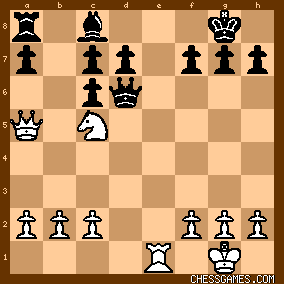
click for larger viewBlack is up a pawn. But who is winning? Marco says White here has a "decisive positional advantage." Schlechter says that Black here "cannot develop without disadvantage. Teichmann, however, states that Black is OK: "I see no immediate disaster while Black has a solid pawn." I am in the Teichmann camp on this one. White does have a bind on the position, but I see no easy way for White to exploit this. And, of course, a pawn is a pawn. One thing is for sure, after Janowski's 17...Qe7, White's advantage is obvious. From here on, Schlechter gives a textbook demonstration on how to win from such position. The conclusion is inescapable: Janowski should have played 17...Qxe5. With his actual move (17...Qe7), Schlechter obtained just as dangerous a bind on the position as after 17...Qxe5...without giving up a pawn. I will address the manner in which Schlechter went about converting his edge to victory in my next post. |
|
Oct-17-17
 | | KEG: After Janowski's 17...Qe7, the position was as follows: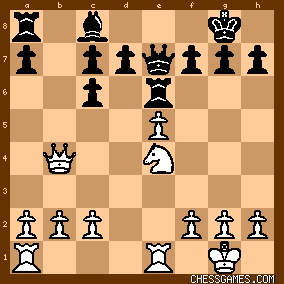
click for larger viewSchlechter's play from here is fabulous.
18. Nc5!
Offering a pawn Janowski dare not take, and tightening his vise on the position: 18... Rg6
If 18...Rxe5?? 19. RxR QxR 20. Re1 winning. (Noted by Rosenthal in the Tournament Book). 19. Re3 a5
20. Qd4 Rb8
Hoping for counterplay on the b-file. But Schlechter deals with this possibility immediately. 21. c4!
"To prevent 21...Rb5" (Marco).
21... h6
22. b3
Perhaps more forcing was 22. Rd1, but Schlechter's move permanently shuts down Janowski's hopes for Queen-side counterplay. 22... Kh7
Janowski is losing patience. 22...d6 or 22...d5 were better, though he would still be in trouble. 23. Rd1
A brief hiccup by Schlechter, giving Janowski a glimmer of hope. 23. Nd3 was better. 23... Qg5?
This was Janowski's last chance to offer serious resistance. As Teichmann has pointed out, Janowski should have played 25...d5 and then after 26. exd6 [26. g3 is arguably better] Qxd6 White would have a good game "but this line of play would have given a better chance for Black than the actual continuation." (Teichmann). Unfortunately, Teichmann spoiled his otherwise fine analysis by suggesting that White could maintain his edge here with 25. Re8, overlooking the reply 25...Bh3! The move that would confirm Teichmann's assessment was 25. h4. After the text, Schlechter closes the door on Janowski: 24. Rg3 Qf5
25. RxR fxR
25...QxR was much better, though Janowski's position would still be nearly hopeless. 26. h3 Ra8
Janowski now hopes to break free by sacrificing his a-pawn. But Schlechter will have none of it. 27. a4
Perhaps 27. h4 was as good or better, but the text is part of Schlechter's iron logic in this game...Janowski is not to be allowed any chance of breaking loose. 27... Rb8
28. Rd3 Qg5
29. Kh2
29. f4 immediately may have been better, but Schlechter knows what he is doing here. 29... Qe7
30. f4 Qf7
The crucial position towards which Schlechter had been pointing has been reached. The manner in which Schlechter closed out the game from here will be addressed in my next post on this game. |
|
Oct-17-17
 | | KEG: <Straclonoor> You are also correct that my 8...Nb2 was a typo and that I intended to type 8...Nb7. Thank you for your corrections! Sorry for my sloppiness. |
|
Oct-17-17
 | | KEG: After Janowski's 30...Qf7, the position was as follows:
click for larger viewSchlechter then played:
31. e6!!
I love this move. It completely paralyzes Janowski. As Shalgo noted on this site: "Black is completely helpless in the face of White's coming attack." "Very neat--the move prevents BLack from ever getting his Bishop and Rook into play by sacrificing his d-pawn." (Teichmann). I gave the position to Fritz 10 which--after a 22-ply search--settled on the strong but inferior 22. g4. I did not see this move coming while playing over the game, but was awestruck when I uncovered Schlechter' move. This move alone demonstrates Schlechter's genius. Not even a 21st century computer program could find what Schlechter unleashed on Janowski 117 years ago. After 31. e6, Janowski never had a chance.
31... dxe6
32. Qe5
The point of Schlechter's move. White is a pawn down, but he controls and board and Black can only shuffle his pieces and await his inevitable doom. 32... Qe7
33. g4!
Schlechter continues his constriction of Janowski. 33... Rb4
A desperate Janowski seeks salvation through a sacrifice of his a-pawn. Schlechter could now win back his sacrificed pawn beginning with 34. Ne4. 33... Qf8 or 33... Ra8 may be theoretically best, but that would only delay Black's demise here. So Janowski offers a pawn in return for some counterplay. Will Schlechter take the bait? 34. Kg3!
Schlechter is not interested in trifles and ignores the chance to claw back a pawn. Fritz plays the unimaginative 34. Ne4 here, but Schlechter understands this position much better than does my computer. 34... Rb6
35. h4 Qf8
Janowski should probably have played 35...Qf7, but this would only prolong Black's hopeless defense. 36. h5
Perhaps 36. Ne4 is stronger, but Schlechter's move maintains his bind on Black's game. 36... gxh5
37. Qxh5 Rb8
38. Qe5 Rb6
38...Qf7 is perhaps better, but it hardly matters in the face of Schlechter's relentless siege on Black's position. 39. g5
"!"--(Rosenthal in the Tournament Book).
39... h5
As Schlechter pointed out after the game, had Janowski played 39...hxg5 (which is probably best) here, White would play 40. Qxg5 followed by Rd8. Janowski's move allows Schlechter to finish quickly and neatly. I will discuss the closing moves in my next post on this game. |
|
Oct-17-17
 | | KEG: After Janowski's 39...h5, the position was as follows:
click for larger viewFrom here, Schlechter finished the game off quickly, efficiently, and brutally. 40. g6+!
Black has no adequate answer to this move.
40... Kg6
"Compulsory; if 40...Kg8, either 41. Qxh5 or 41. Qg5 would win easily." (Teichmann). But, as Schlechter demonstrates, the text is equally hopeless. 41. Qg5+ Kh2
42. Qxh5+ Kg8
43. Qg5 Kf7
43...Kh7 would have prolonged the agony.
44. Rd8 Qe7
Now it's mate in six.
45. Qh5+
1-0
As Teichmann noted, White mates by force after 45...g6 (if 45...Kf6 46. Ne4 mate) 46. Qh7+ Kf6 47. Qh8+ Kf7 48. Qg8+ Kf6 49. Rf8+ [and mate next move]. |
|
Mar-31-25
 | | OhioChessFan: Strong game, love <KEG's> analysis, don't get the pun. |
|
Mar-31-25
 | | offramp: The beatings will continue until morale improves. |
|
Mar-31-25
 | | Honza Cervenka: <They all agree that after 17...Qxe5 best play would be 18. Nc5 Qd6 19. Qa5 RxR+ 20. RxR>
click for larger view Let's try to prolong this line. It is apparent, that black must react on threatening mate on e8. Of course, 20...g6?? is bad here for 21.Ne4 Qd4 22.c3 Qg7 23.Qxc7 and black can just resign. 20...Kf8 is not much better. Again 21.Ne4 gives white huge advantage, for example 21...Qd5 22.Qxc7 Ba6 23.h3 with intention 24.Nd6 and 25.Qxd7. 20...f5 and 20...f6 significantly compromise black Kingside and 20...Qf8 returns the Pawn (21.Qxc7) and white is better. And so 20...h6 is clearly the best move of black. Now 21.Ne4 is playable but after 21...Qe7 22.Qxc7 f5 23.Qd6 Kf8 24.Qxe7+ Kxe7 25.Nd2+ Kf6 white gets just an equal R+N vs R+B ending. More promising seems to be 21.Re8+ Kh7 22.Nd3. Now 22...Qd5 is practically forced, and white has a choice between trade of Queens and 23.Qxc7 Qxa2 24.h4 with initiative. From the perspective of black it could have been better than the continuation in the game, but far from paradise. |
|
Mar-31-25
 | | FSR: <OhioChessFan: . . . don't get the pun.> Black's rook and bishop were sentenced to home confinement/house arrest? |
|
|
|
|





